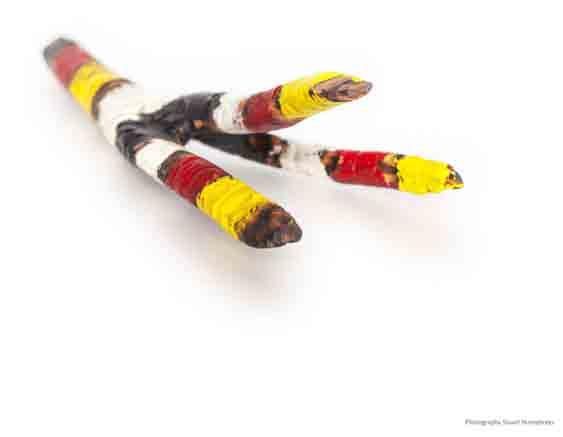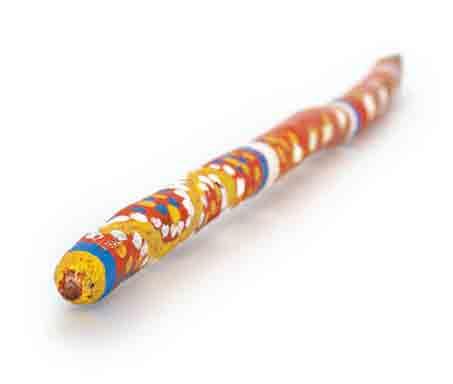
7 minute read
Photofeast Two stunning, award-winning photographs
Left
Carved ceremonial turkey foot (Wirliya), used by women in Turkey Dreaming dances. Painted by Judy Nampijinpa. Made of softwood from the Yinirnti tree. E077970
Below
Women’s ceremonial club (kuturu). E078484
With support from the Australian Museum Foundation, we are exploring the evolution of contemporary art practice over the last thirty years in the Aboriginal community of Yuendumu, 300 kilometres northwest of Alice Springs. Working in collaboration with Warlukurlangu Artists, the community’s art centre, we will commission a series of paintings and collect a range of other works that reflect the contemporary visual arts produced in the community. This new material will build upon and reference a unique collection of art drawn from the community a generation earlier when the women first began to experiment with commercial art.
WOMEN ARTISTS
In October 1982 the Australian Museum held a world first: an exhibition by female Aboriginal artists. Nine Warlpiri women from Yuendumu travelled to Sydney (two paying their own way) to show their work and demonstrate traditional body painting, songs and dances. The women had only just begun to experiment with painting for a wider audience and this exhibition, called Women Artists, was their first public venture. The Museum is lucky to have within its collections the several hundred painted objects from this groundbreaking exhibition, along with other Yuendumu artworks collected around this time. They represent a critical period in the life of the community – as women began to experiment with the use of acrylic paints and the production of art for the commercial market. Just a handful of the works are painted on canvas; most are on carved wooden objects such as dance boards, bowls, carved eggs, clap sticks and digging sticks. Unlike today, many of the works were painted with fingers rather than brushes. They are made on bones and grinding stones as well as wood and canvas, and traditional ochre is often used alongside modern acrylic paint. There is an experimental quality to these works – hardly surprising given that the artists were grappling with how to render designs traditionally painted onto bodies or sand into a form suitable for sale. However, it is striking that all the elements that have made Yuendumu artists such an enormous critical and commercial success are present: the vibrant colours, the recurring use of dots as a graphic motif and, perhaps most importantly, the strong association between the artworks and the Jukurrpa (loosely translated as the Dreaming, or the time when the ancestral beings made epic journeys, shaping the landscape as they went and laying down the rules of behaviour for future generations to follow). The continuities are all the more striking because the objects represent not only artistic innovation, but a radical social experiment. Women old enough to remember nomadic life in the desert were experimenting with how to engage a modern market economy. Elders were exploring how to allow secret and sacred Jukurrpa stories to be appreciated by a wider public. Gender roles in the community were actively being contested and renegotiated as women began to paint and share their stories in a way only men had done previously. The continuities reflect how quickly community members were able to resolve these issues and move on to carve out a successful place in the contemporary art world.

RECOGNITION
At the time, Women Artists passed with little attention from the critics or the public, but over the next few years recognition came quickly for the Aboriginal art world. For example, at least 50 major Aboriginal art exhibitions were staged during the Australian Bicentenary in 1988, including three in the USA. Suddenly private galleries specialising in Aboriginal art were springing up in Australia’s major capital cities and around the world. In Alice Springs alone there were 30 outlets – including the local Kmart – selling Aboriginal art. By 1988 all the major national and state galleries had acquired curatorial staff specialising in Aboriginal art and were actively competing against each other to acquire new work. Recognition came fast to Yuendumu too. Soon after Women Artists, the men began painting the famous Yuendumu Doors (a series of stories painted onto the doors of the Yuendumu School) in 1983. Warlukurlangu Artists was established in 1985, and the cooperative has now taken part in more than 1000 exhibitions around the world, with a financial turnover that puts them among the five most commercially successful Indigenous art centres in Australia. When I visited Yuendumu recently a party of artists from Shanghai was there on a study trip, while local artists spoke of their upcoming projects in China, Singapore and Germany. Like the art on the Quai Branly and Qantas jet, Yuendumu artists and their works are on the world stage. Our collections give us a unique opportunity to understand and appreciate how they got there so quickly.

DR SCOTT MITCHELL, HEAD, CULTURE, CONSERVATION & COLLECTING
By making a donation to the Australian Museum Foundation, you can help support more projects like Yuendemu Stories. For further information, please see the back cover or contact the Development Branch, telephone 02 9320 6216.


Top
Women’s ceremonial wooden dish (parraja). Painted by Biddy Napanangka. Made of softwood from the Yinirnti tree. E078306
Left
Women’s ceremonial digging sticks (karrparnu) held during dances, painted by Bessie Nakamarra (E078404, left) and Mona Napurrurla (E078423, right).
meet KIM McKAY
continued from page 2 Genographic Legacy Fund benefitting indigenous communities around the world. But I’m not coming in to the Museum to put my own personal passions on display. The team at the Museum has some great plans for engaging the public into the future and we have some ambitious targets for building attendance, and how we do that will be top of mind. Will you be continuing Frank’s strong stand on biodiversity conservation and climate change? Climate change is not a belief system; it’s about science, and there is an overwhelming body of scientific opinion that says there is a very real and rapid change happening to our planet. I’m not interested in personal belief systems; I’m interested in science and in communicating that science to people. I have been on the record for a long time as an advocate of generating awareness of the impacts of climate change and will continue to do that. The Museum is uniquely placed to continue to do climate change research linked to biodiversity and conservation, and we have a responsibility to show that this is an issue that needs more understanding, continued research and greater engagement. It is one of the key pillars of the Australian Museum Research Institute.
As a Museum Trustee over the last two years you’ve helped establish the New Museum project. Can you tell us a little about that? I can only touch on it at this point, but it’s a large, complex project that will basically allow us to create much-needed floor space for exhibitions by developing the under-used eastern end of the College Street site. We have one of the best Pacific collections in the world and I believe this needs to be front and centre because of our role as a country in the Pacific region. I also think our Indigenous collection is extraordinary and needs to be showcased more too.
And I see opportunities for taking some of the larger travelling exhibits that are out there, but we simply don’t have the floor space to show them. Plans are still being developed, so all I can say is, stay tuned for those announcements. What personal challenges do you anticipate in running the Museum? Well, one is I’ve never worked in the public service previously. Bureaucracy is always an interesting thing to come up against, but I always seem to find ways to get around it [laughs]. That aside, I want more Museum science to be showcased on the floor of the Museum, to bring the science out, because people find it amazing. And bringing in more families and kids is critical.
Being the first female director of the Museum is an incredible honour, but there are big shoes to fill and I’d like to acknowledge all the work that Frank and his predecessors have been doing. Of course a new director will always want to put their stamp on things, but I need to get in there and understand it first. The Australian Museum has been doing great work on many fronts and that needs to continue. We’ve got an important role to play in the whole fabric of this city and state as a major cultural and science institution.
DIRECTOR-IN-WAITING KIM McKAY SPOKE TO BRENDAN ATKINS
WEBLINK
Find out more about Kim McKay at www.australianmuseum.net.au/Explore-magazine








